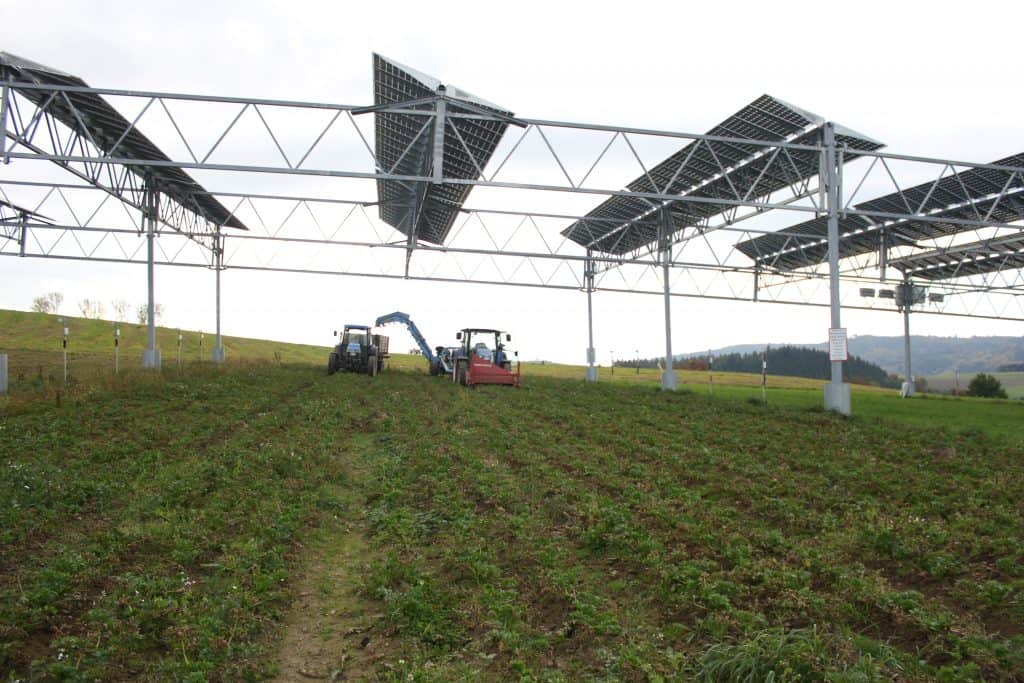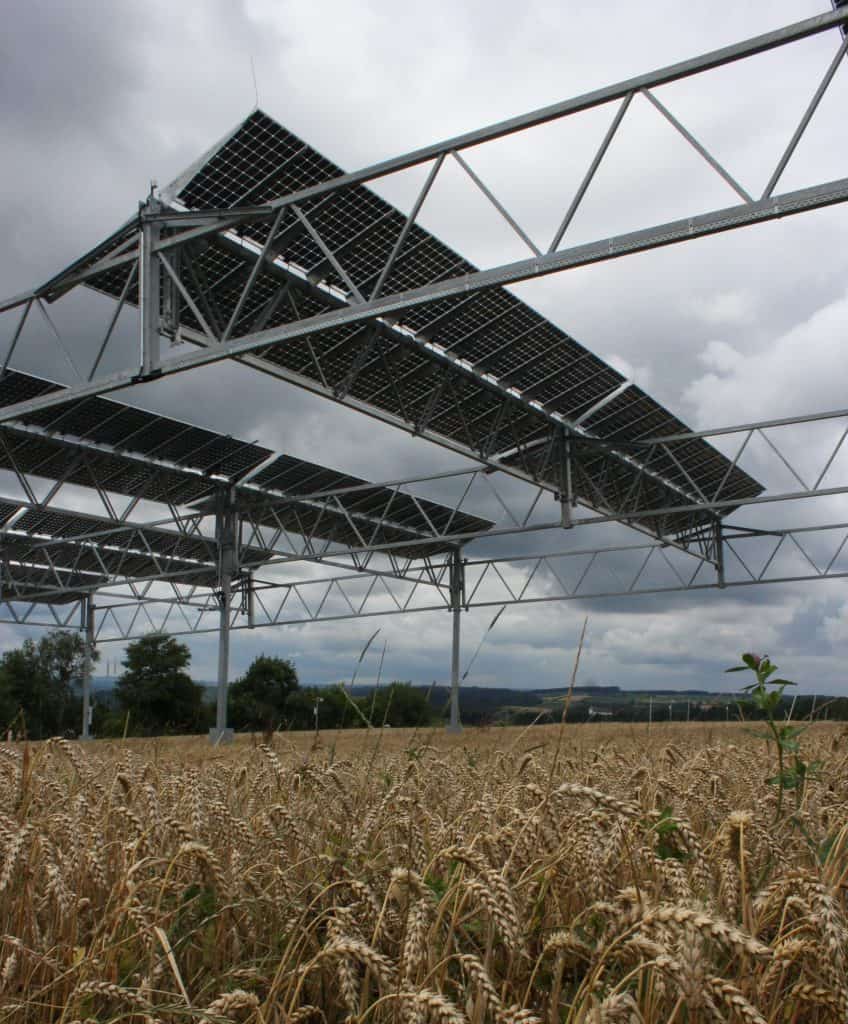The organic farm community of Heggelbach in the rural alpine upland of Germany’s Baden-Wuerttemberg state is like something out of a fairy tale. Hens cluck in front of the quaint yellow farmhouse, majestic Braunvieh cattle graze among spring daisies in the meadows, and wheels of Camembert ripen in the recently built cheesery. But 20 feet above the crops is something altogether more modern: Steel columns holding 720 gleaming panels comprising 27,000 square feet of state-of-the-art solar technology.
Heggelbach, which adheres to the strict biodynamic rules of the Demeter Federation, is engaged in a radical experiment. Under the guidance of the German Federal Ministry of Education and Research, the Fraunhofer Institute for Solar Energy Systems (ISE) and the University Hohenheim, the farming community built Germany’s biggest solar installation under which crops can grow, a method known as agrophotovoltaics (APV). In winter, the panels ward off the snow; in the summer heat, they afford much-needed shade. And they are high enough for farmer Florian Reyer to navigate his tractor through the rows of potatoes, celery, trefoil grass and wheat seedlings underneath. The researchers chose these four varieties for a reason. “They wanted to test a vegetable, a grain, grass, and potatoes as a typical German staple food,” Reyer explains.

In the summer of 2016, the researchers installed the pilot panels at a cost of 660,000 euros ($700,000 USD). They then spent three years analyzing temperatures, harvest and water saturation to answer a question for struggling farmers worldwide: Could the pairing of innovative solar technology and regenerative farming allow farmers to harvest an abundance of vegetables and electricity?
Farming food and sun
Squeezed by rising energy prices and declining crop returns, farmers from Asia to the United States are looking for ways to reap multiple streams of revenue from their land. At the same time, many countries are looking for more places to install renewable energy projects. In places where electricity brings in more money than crops, they’re eyeing vast tracts of farmland. Researchers at Oregon State University calculated that if nearly one percent of agricultural areas worldwide could be converted into solar farms, global energy needs could be satisfied.
But “only” one percent is actually a lot. In most countries, every acre of farmland is badly needed. Worldwide, the ratio of farmland to person sank by 50 percent in the last 50 years. Meanwhile, the world will need to grow 50 percent more food by 2050 to keep pace with population growth, even as food crops are cleared to make space for more roads, buildings and biofuel crops. In Germany, for instance, 250 million acres of farmland have been planted with monocultures such as corn and grains that are not grown for consumption, but for conversion into so-called biodiesel. Our hunger for energy leads to actual hunger.

This is why passionate farmers like Reyer demand that farms not be given over to solar arrays. “Solar parks are not sustainable and not ethical,” he says with a surprising sharpness. “I view the trend to build solar parks on agricultural grounds very skeptically.”
Yet Reyer’s fears are being realized. Solar farms currently cover more than 25,000 acres of agricultural areas in Germany, funneling up to 5,000 euros per hectare in leasing fees to the farmers who own the land. “I could lounge on my couch, sit back and earn more by giving my acres to a solar park investor than by using my manpower to grow wheat or potatoes,” Reyer says, shaking his head. “No way!”
But what if it wasn’t a choice between one or the other? Can crops and solar panels coexist? Some farmers let livestock graze beneath solar panels, but livestock require far more arable land than crops. “Sure, I could install solar panels and let some sheep graze underneath,” Reyer says. “But this is not sustainable long-term. We won’t be able to feed the population this way.” What he and his fellow farmers at Heggelbach are attempting is far more complex. If they can pull it off, it’s a model that could provide a path forward for both struggling farmers and energy-hungry societies.

Pioneering a solar-powered community
The Fraunhofer Institute recently published findings that detailed the advantages of Heggelbach’s novel system of perching solar panels high above its crops. The study found that the panels produced significantly more electricity than predicted, and maintenance was easier than farmer Reyer had feared. “We thought we would have to clean the panels much more frequently,” he says. “Even in winter, the snow simply glides or melts off.”
The farming community rents the panels from Fraunhofer and uses the electricity produced to run the farm, the cheesery and the milking machines. The panels are bifacial, meaning both the front and the back transform sunlight into electricity, making them extremely efficient. Any surplus is fed back into the grid, especially in the summer, when it exceeds the community’s needs.
The Heggelbach community was an early adopter of innovative energy generation. In 2006, the pioneering farmers installed solar panels on their roofs. In 2008, they built the first wood gasifier, which heats their homes, the cheesery and the hay dryer. The next year, they received the German Solar Award for their sustainable energy production.
Like most in the community, Reyer is deeply passionate about sustainable farming. “I’m a farmer with an affinity for technology, not a technician,” he says. His parents co-founded this community and raised him here. Now he lives here with his wife, their three kids and four other families. Not to be mistaken for a country bumpkin, he follows developments in agrophotovoltaic technology closely. The governments of South Korea, Japan and China, for instance, are subsidizing hundreds of thousands of AVPs, and testing new modules with flexible panels that follow the sun or filter radiation harmful to plants. “South Korea deliberately invests in AVPs because they don’t have enough farmers, similar to us,” says Reyer. “The AVPs finance pension funds, and the young farmers can work underneath the panels without making giant investments.”
Crushed by negative news?
Sign up for the Reasons to be Cheerful newsletter.In Lower Saxony, a company called Agrosolar Europe will soon build a giant new AVP with state subsidies. Its goal is to harvest 30 tons of chives and herbs per year. Then-state secretary Jochen Flasbarth lauded the project at its groundbreaking in June 2021 as “a win-win for the climate, agriculture and food production.”
It’s not as easy as some make it sound. “The solar panels reduce our harvest by 10 to 15 percent,” Reyer says. And Reyer needs more time and manpower to maneuver his tractor around the panels’ steel scaffolding. “Financially, we make up the loss of harvest with the gain in electricity,” he says. Some farmers have tried vertical AVPs, an option the Heggelbach community briefly considered but found too expensive and cumbersome.
The weather can also be make or break. “We had severe drought in 2018 and extreme rain and cold in 2019,” Reyer remembers. “During a drought, the plants benefit from the panels’ shade, but when it rains a lot, the main issue is that the water gets distributed very unevenly because of the panels.” Some plants don’t get enough water, while others drown.
On the other side of the planet, in Colorado, farmer Byron Kominek has had similar experiences. “I plant the squash in the dry spots and the green leaves where it’s wet,” he says. Near Boulder, Colorado, Kominek has built the largest commercially active agrovoltaics system in the U.S. A former diplomat with USAID, he moved back to Colorado in 2019 and installed a multimillion-dollar AVP with 3,200 solar panels to create a 1.2-megawatt community solar garden on his late grandfather’s farm. Now he is experimenting with 40 different crops, from squash to raspberries, to find the best AVP-harvest that can secure the future of the 24-acre farm, which barely makes enough hay to cover its costs. An engineer by training, Kominek primarily works as a solar power consultant for companies and other farms, using his farm as an experimental test plot. He also partners with the Colorado Agrivoltaic Learning Center to demonstrate to graduate students from Colorado State University, as well as the public, the possibilities of AVP.
Similar to Reyer, he struggles with unpredictable weather events. Drought dust sometimes covers the panels, and a storm blows trash cans past his window while we speak on Zoom. But he is producing enough energy to sell it to about 300 nearby homes, a cannabis farm, a bank, and the City and County of Boulder. “They all pay a premium to support us,” he says.
Because our climate is warming, Kominek, Reyer, and experts such as Max Trommsdorff, head of the agrovoltaics group at the Fraunhofer Institutes, see AVPs are a solution for the future, especially in hot, arid regions such as Arizona, where the harvest of chili and tomatoes improved under the panels.

But as a regenerative farmer in Germany, Reyer has to balance multiple factors and goals such as soil quality, biodiversity, crop rotation, harvest and manpower. He pleads for more research — for instance, about how the problematic water distribution issue could be solved. As a pioneer, he answers calls nearly every day from other farmers who are keen to try AVPs. “In reality, we need another four or five years of detailed research to meaningfully investigate how different crops respond to different weather events under the panels long term,” he says. “However, the grant money for the research has run out. It’s extremely difficult.”
His vision is to make the community farm entirely independent by generating enough energy and heat to harvest in harmony with the principles of regenerative farming. “But in terms of money, our society is willing to pay more for electricity than for agricultural products,” he says. “I see this as the biggest discrepancy: We value electricity more because our plates are full.”
To sum up, the solar farmers can solve one problem. But to solve the bigger issue — namely, that our society is more eager to grow watts than wheat — is too big for them to solve alone.






